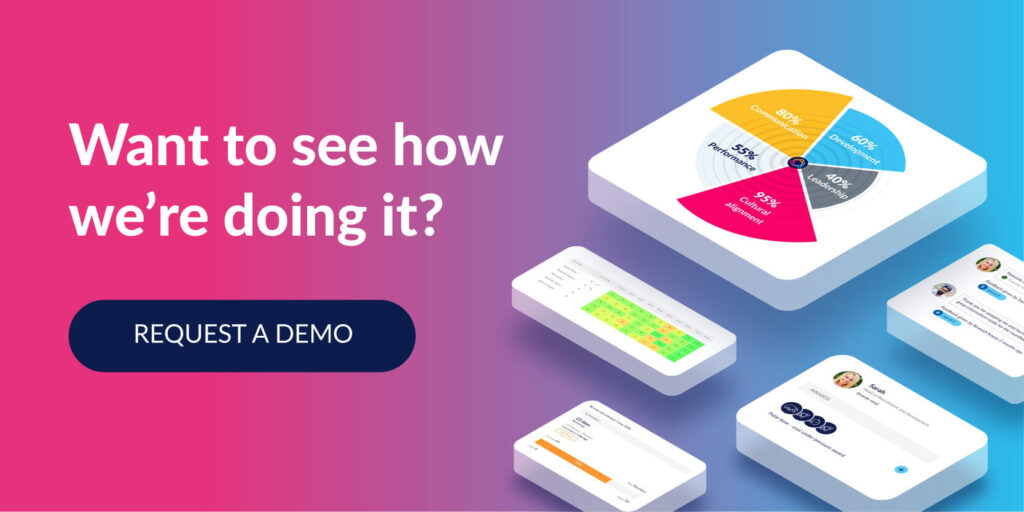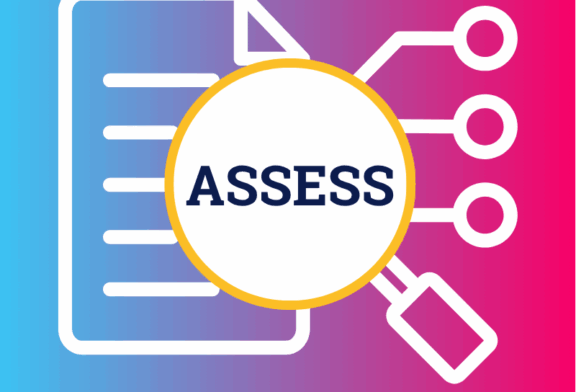The 9 box grid has been the succession planning tool for decades.
A visualisation of all your employees, based on potential and performance?
Sounds great. But is it actually effective?
Are you able to categorise all of your employees in just 9 vague phrases? We definitely couldn’t.
9 options wouldn’t even be enough to categorise what colour car we all drive. What city in the world we work from. Our favourite type of music.
You get the point.
Every member of our team has their unique strengths and abilities. They put in the hours to make sure that our business succeeds, and they progress in their development.
How on earth would we group them into 9 boxes?
We don’t think it’s possible. And thousands of other HR leaders feel the same way.
What is the 9 box grid?
Simply put, the 9 box grid is a succession planning tool.
It helps HR professionals visualise their workforce to identify employees’ strengths and weaknesses.
9 box grid aims to pinpoint employee performance, allowing leaders to better understand talent management.
Each grid section represents a category of employees. They are sorted based on their performance and potential.
If you’ve been in HR as long as we have, you’ll have probably seen one.
It looks like this:
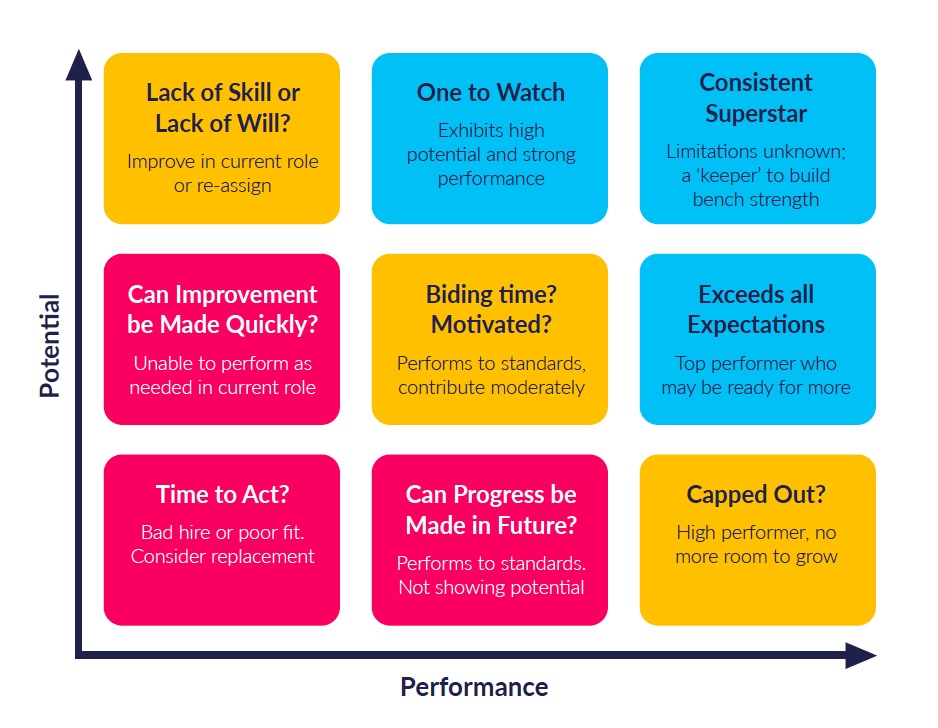
When done right, HR teams get an at-a-glance overview of employee performance and potential.
Aims of the 9 box grid are:
- Finding succession opportunities
- Creating training plans for development
- Understanding areas for concern
- Influencing hiring strategies
- Tracking employee progress over time
It’s been used for decades, so it must be useful. Right?
Kind of. We’re among the growing number of people management voices who think it’s become outdated.
We’re not denying that it has its uses.
We just think that succession planning can be done better.
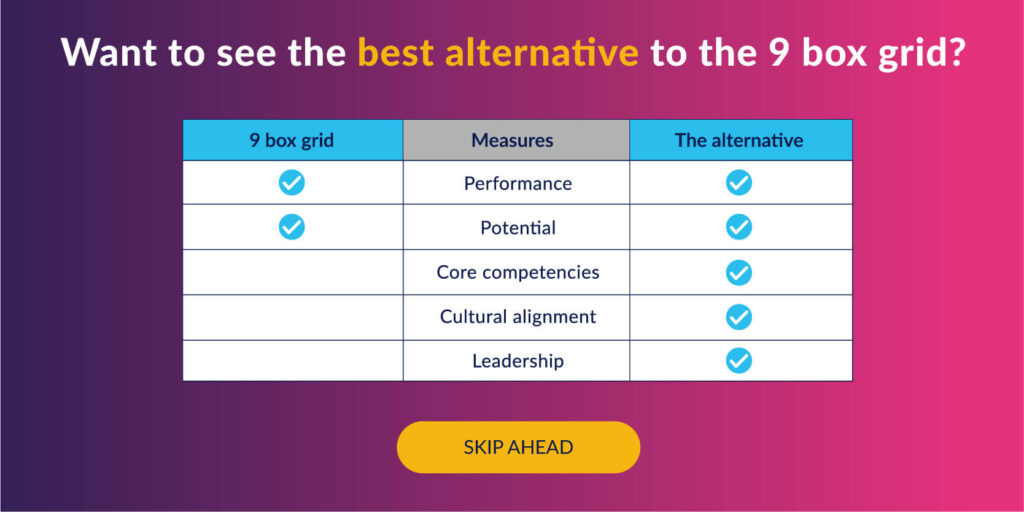
Deloitte did a study and found that lots of businesses don’t take succession planning seriously.
In their words:
More often than not, we found that companies were either avoiding succession planning altogether or were taking a dispassionate, process-oriented approach that minimises, or even ignores, the very real impact that it has on the people involved.
Sound familiar?
The dispassionate approach they reference is none other than the 9 box grid.
It takes the ‘people’ out of ‘people management’. And that’s not good enough in 2024.
The 9 box grid is outdated and it sucks
The 9 box grid was first created in 1970.
A revolutionary people management process for its time, sure.
Changes to the working world were underway.
It was a period of hardship, with strike actions prevalent. However, the Treasury had published its first official strategy for economic growth less than a decade before.
White-collar workers wanted to climb the corporate ladder. More people than ever started searching for careers, rather than jobs.
The opportunities were there, but senior leadership had no way to assess their workforce. And they certainly didn’t have a way to prove who should become the future of the company.
McKinsey created a visualisation to compare business units subjectively. This was then adopted by HR to generate an overview of employee performance and potential.
In a sense, this was the working world’s first step towards strategising employee success.
It was acceptable in the 70’s
The world was different in 1970.
Ashtrays on every desk. Computers that filled entire rooms. Proposals sent through the post.
Doing business was totally different. You had to be in the room to be part of the conversation. Want to make big decisions? Get promoted? Earn a great wage?
Better hope you’re in the right place, at the right time.
Hierarchies were strict, and it took years of work to start to make the climb towards leadership.
And forget ’employee first’ policies. Employers set the standard, you had to fall in line.

Employee success has evolved
The world of work couldn’t be more different than 1970.
Employees now have the power to dictate how they’re treated at work. Flexible hours, hybrid working and lucrative benefits are now commonplace.
And let’s not even mention the changes brought on by the pandemic…
Employees are no longer afraid to leave a job if they aren’t satisfied. Shorter tenures and quicker progression are now the norm.
Employees expect more. And they aren’t afraid to demand better opportunities.
How do you keep hold of the best employees? Focus on their success.
Succession planning: think outside the box
There’s no way that every employee can be categorised into one of nine choices.
People don’t want to be labelled as ‘good’ or ‘bad’.
There’s so much more nuance in how every employee is defined. They might have strengths that can’t be categorised by the 9 box grid.
The key is to recognise the individuality of each person in your team.
No matter whether there are 10 or 10,000 of you. You need to start looking into the specifics of your employee’s performance and potential.
- Assessing performance, but based on individual strengths
- Understand how their engagement and alignment to company values impacts others around them
- Create personalised development plans that match their growth potential
Gen Z (Digital Natives) and the future of work
Look out: Gen Z are here. And they’ve changed the way business works.
They don’t want to follow the rules ‘just because’. The latest addition to the world of work need to have a purpose.
And that doesn’t just mean an altruistic purpose. They aren’t as willing to stick with the status quo on expectations as past generations.
Businesses need to catch up. To keep hold of the brightest new talent, you need to demonstrate your dedication to employee success.
Forget throwing some bean bags into the break room. Dress down Friday? They don’t care.
You need to make the employee journey enjoyable and fulfilling. Create better job satisfaction.
That starts with how you treat them at work, but better succession planning is the key to better retention.
How to find future leaders in 2025
In an ideal world, teams would grow in strength and maturity over a number of years.
When it was time for a manager to retire, their number two would swoop in and take the reins.
But it’s not that easy. Things happen. In today’s market, people move on, faster.
To succeed, you need to retain the best talent, those who could fit into future leadership roles.
An employee-centric succession planning process is key to finding future leaders. It also helps you to keep them with you.
Why is the 9 box grid still used in 2025?
Listen, we’ll admit there are some advantages to 9 box grid.
It’s better than using nothing, for a start.
If you use the 9 box grid in your performance management strategy, you recognise the need to take succession planning seriously. And you’ve implemented an industry-recognised talent management process to do so.
You might agree with the following:
1. It can be easy to get started
As an established tool, the 9 box grid model is familiar to most people working in HR or people management.
It has an intuitive layout, easy-to-read results and simple structure.
The values inputted require a consensus from managers and HR leaders, so it is tailored to each employee. This works best with the use of 360-degree feedback.
2. It can help to identify valuable talent
The visual nature of the 9 box grid makes it very easy to identify employees with potential.
It’s easy to spot who’s struggling, or needs to make changes, too.
As an at-a-glance visual, it’s great to get an idea of your workforce. It doesn’t go into detail, but it makes a great starting point for assessing performance.
3. It starts a discussion on performance and development
Open and honest communication between managers and leadership are essential to craft an accurate 9 box grid.
Everyone who interacts with a given employee will have insights both into their current performance and their ability to learn.
You can get a really clear idea of how managers perceive their team. A clear insight into how your leaders are managing talent.
4. It can help with future planning across the company
When leaders can easily assess employee potential, they can invest the time, resources and effort in employee development.
It takes time to develop into leadership positions. The 9 box grid offers a competitive edge by identifying high potential candidates early.
This is also useful for effective talent retention and talent management.
Long-term development goals can be created for upcoming leadership talent. With a clear vision and end-goal in sight, they’re more likely to stay with you for longer.
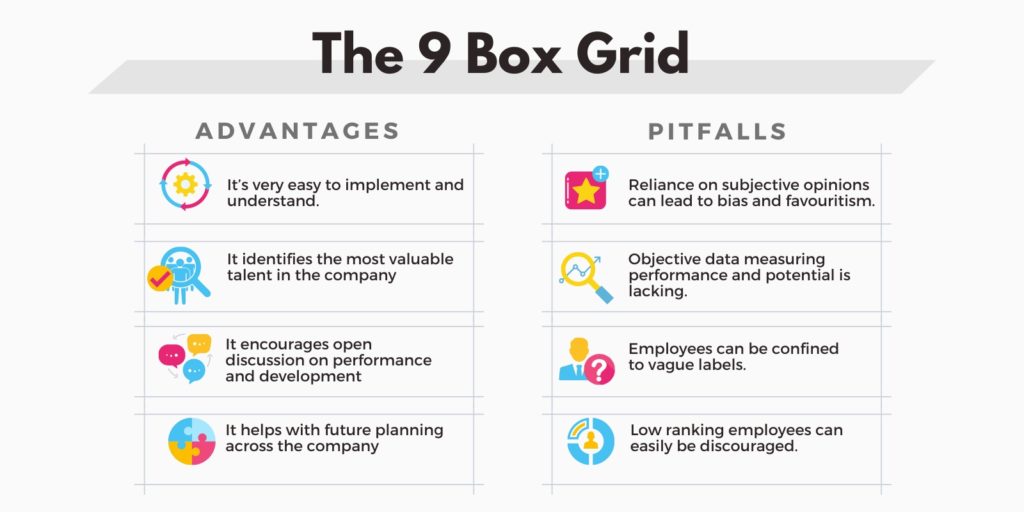
Common 9 box grid pitfalls
We’ve been pretty clear. We think that the 9 box grid isn’t fit for purpose in 2024.
If you’ve read this far, chances are that you think the same way we do.
We’ve already covered the main disadvantages. But there are more that we’ve not had chance to mention. These include:
1. Reliance on subjective opinions can lead to bias and favouritism
The 9 box grid process involves gathering information from multiple sources.
However, few of these are fact-based. Opinions on future potential are pretty subjective, and can be influenced by coworker relationships and personalities.
Gathering input from a variety of team members can limit this risk. However, you’re never going to be 100% whether bias has reflected in any opinion.
2. Objective data measuring performance and potential is lacking
Concepts such as ’employee potential’ are hard to frame in unambiguous terms.
It’s so difficult to measure this in an objective way.
Fail to remain objective? Your 9 box grid becomes inaccurate and misleading.
3. Employees can be confined to vague labels
The labels used in a 9 box grid model are vague.
‘High potential moderate performer’ as a descriptor could fit a huge range of definitions.
Consider whether describing someone as ‘medium potential’ has any real bearing on how well they’d progress.
Doesn’t really give enough insight, does it?
4. Low-ranking employees can easily be discouraged
‘Low potential’ isn’t a phrase to be used lightly.
Low-potential employees might be some of your best performers. There’s nothing wrong with an employee who comes to work, does a great job and doesn’t want to progress to a higher level.
They’re the backbone of business success. And finding out that you consider them ‘low’ anything could be totally demoralising.
How to create a 9 box grid
One of the reasons that 9 box grid is still used today is its simplicity. There hasn’t been an alternative that’s as easy to use, that delivers more in-depth insight.
If this is your first time delving into succession planning, understanding the basics of the 9 box grid methodology will help.
There are three main steps to creating a 9 box grid. These are:
1. Assessing employee performance
The first step is to understand how well every employee performs their role.
Take a look at each employee’s current performance. How often do they achieve their Key Performance Indicators (KPIs)? Are they consistently hitting target, or do they often fall behind?
Using performance management software is the easiest way to get of evaluating performance accurately. The data is generated from performance scores against measurable expectations.
- ‘Low performance’ employees don’t perform as expected, frequently missing personal targets or deadlines
- ‘Moderate performance’ employees typically meet their job requirements, although there are some lapses
- ‘High performance’ employees consistently hit target, regularly exceeding performance expectations
2. Assessing employee potential
Unlike performance, assessing potential is based on subjective opinions.
You need to be careful to avoid bias. One way to reduce this is by getting feedback on potential from as wide a range of people as possible.
Just like performance, it’s also measured as low, moderate, or high potential.
To properly split each employee into different talent categories, you need to consider:
- How motivated the employee is
- What level of expertise they have demonstrated
- How frequently they have learned new skills
- How willing they are to take on board coaching and mentoring
- How proactive they are in taking on new challenges
- Expected future behaviour
3. Merging performance and potential into a 3×3 grid
The final step is simple.
Plot the employees on an overall 9 box grid.
From there, you will have a single visualisation of your best candidates for future leadership.
How to make the 9 box grid better
If you choose to use the 9 box grid, vague descriptions will hold you back.
You can add context to justifications by using the 9 box talent matrix.
For example:
| “A potential star” Low performer High potential | “Shows great potential” Moderate performer High potential | “An A-player” High performer High potential |
| “Inconsistent employee” Low performer Moderate potential | “A core player” Moderate performer Moderate potential | “High performer” High performer Moderate potential |
| “A high-risk employee” Low performer Low potential | “An average performer” Moderate performer Low potential | “A solid performer” High performer Low potential |
But even then, you’re stuck using labels. What do they actually mean?
- A high-risk employee: low performance and limited potential, a candidate for reassignment to a lower level or, in the worst-case scenario, exiting the company
- An average performer: may have reached their potential, a candidate for coaching and other developmental programs
- A solid performer: a valuable employee who delivers results, could benefit from skill development and coaching
- Inconsistent employee: potential for future growth with the relevant coaching and of stretch goals
- A core player: requires coaching and people management skills development, but a potential candidate for future progression
- High performer: their role provides an opportunity for growth and development, with strategic thinking a priority
- A potential star: a seasoned professional with the capability for an expanded role with some coaching and mentoring requirements
- Shows great potential: performs highly in their role and can reach the next level with appropriate stretch goals
- An A-player: a consistently high performance individual who solves problems, sees the bigger picture, and is fully motivated to excel
These descriptors certainly add more context to decisions. But is that enough?
Your succession planning process shouldn’t rely on boxes.
It’s time to identify potential successors, by making it personal.
9 box grid alternatives
It’s time for a change, right?
While the 9 box grid may have been a valuable tool 50 years ago, succession planning in 2024 needs a more intuitive process.
But what is the alternative? Is there a tool that can make succession planning more effective?
We struggled to find one. So we decided to build one.
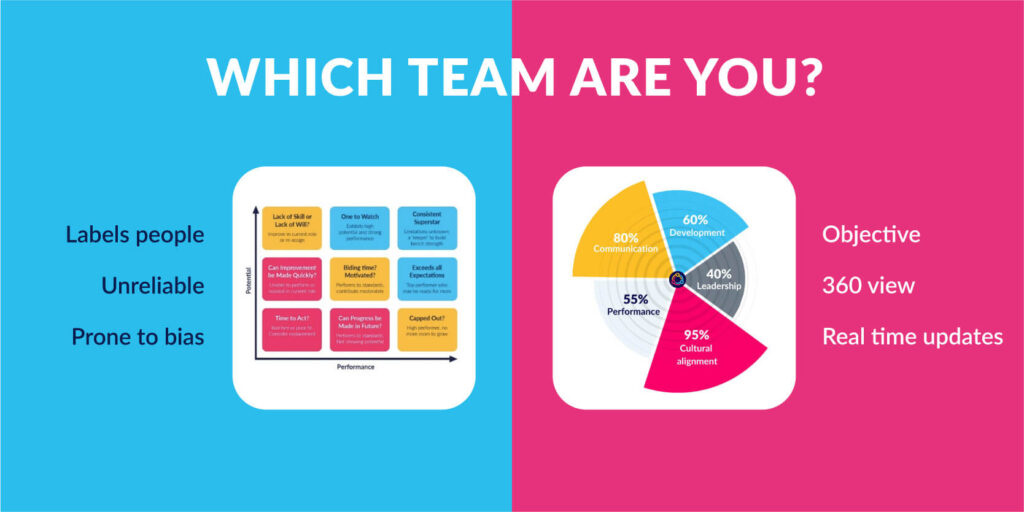
Use Success Circles to improve succession planning
Success Circles make succession planning simple.
An intelligent AI-powered tool, they are automatically generated during the employee lifecycle.
Every objective completed, every award received, every piece of feedback given.
Success Circles analyses it all.
Combine engagement, performance and development
Every piece of feedback your employees receive through the StaffCircle platform is tracked.
Success Circles automatically condense the data. They document the steps of progression from every interaction.
And then automatically create a visualisation.
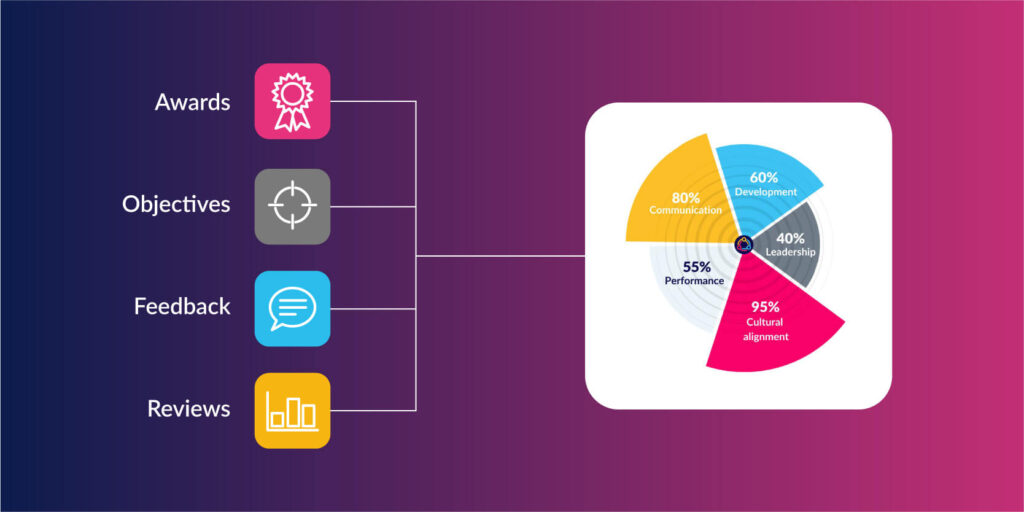
Make succession planning personal
Let’s stop labeling employees. It’s irrelevant and no one likes being put in a box.
What do they like?
A simple way to understand their performance and progress. At a glance.
This is the power behind Success Circles.
No longer a tool for HR leaders to complete in private. No need to gather potentially biased opinions on potential.
Data isn’t biased. And Success Circles helps you to own it.
You can choose what you want to track across the board.
Each segment of a Success Circle displays employee performance and potential.
- Development
- Performance
- Culture and brand
- Communication
- Leadership
The segments grow over time. They can be viewed at any time.
You and your team can get a real-time view to accurately evaluate progress of performance and progression.
The benefits of real-time succession planning
The benefits are vast. Success Circles users list the following advantages:
- Take action, fast, if an employee is underperforming
- Understand who your high performers and workplace champions are
- Identify potential successors and nurture their development
- Involve employees in their own progression
- Create clear personal development roadmaps
- Understand performance barriers and highlight skills gaps
And that’s just the start.
The more you use Success Circles, the more valuable they become.
Compare data month-by-month or year-by-year to see the progress of your strategy come to life.
Clarify leaders expectations on performance management initiatives. Feed back to board members, leaders or investors on how your policies improve business success.
If you’re tired of your outdated succession planning process, it’s time to make a change.
Book a call with our experts. They’ll help you realise your vision for better employee success.
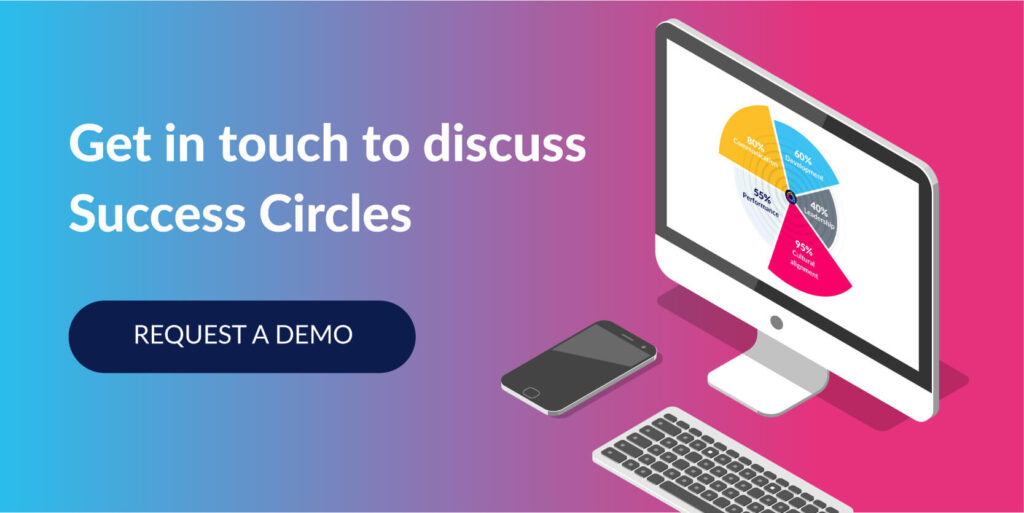
Astronomical expectations for succession planning
Consider this: the 9 box grid was invented just one year after we first landed on the moon.
Think NASA still use the same launch process? Think again.
There’s been 50 years of solid research and state-of-the-art developments since that first mission.
And it’s why companies like Virgin and Tesla can even consider starting space tourism.
In short, a lot of improvements can be made in 50 years.
So why are you still using the 9 box grid when assessing potential?
We want to hear your thoughts. Do you think the 9 box grid still has it’s place in today’s working world?
Or do you think like us? Are you ready for a change?



